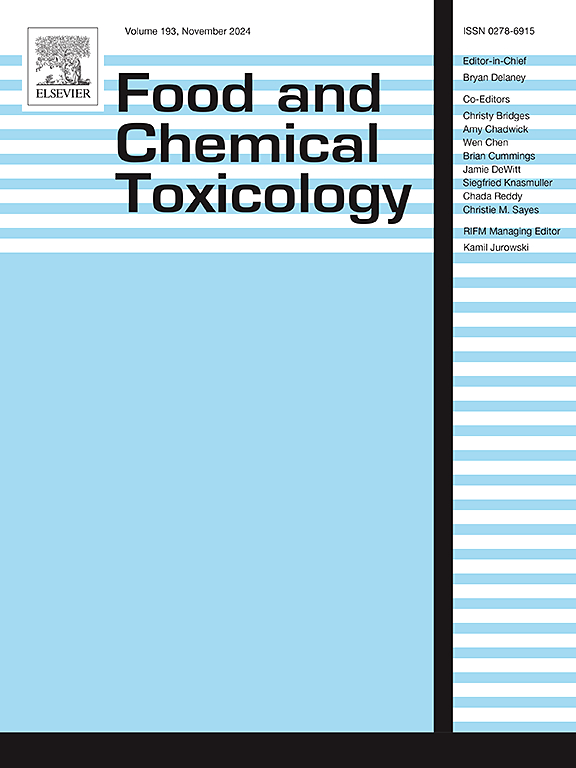金纳米颗粒与诱导大鼠晶状体结构改变和氧化应激增强。
IF 3.9
3区 医学
Q2 FOOD SCIENCE & TECHNOLOGY
引用次数: 0
摘要
纳米技术在医学领域的应用越来越广泛。关于金纳米颗粒(AuNPs)在眼组织中的分布和清除的信息是不充分的。我们研究了AuNPs对大鼠晶状体结构的累积效应及其对氧化还原状态和水通道蛋白-0 (AQP0)表达的影响。雄性大鼠36只,随机分为对照组、AuNPs-200组(200 μg/kg/大鼠,持续4周)和AuNPs-500组(500 μg/kg/大鼠,持续4周)。4周后处死大鼠,对眼晶状体进行组织学、透射电镜、扫描电镜、AQP0免疫组化及形态计量学检测。通过ELISA检测晶状体匀浆中肿瘤坏死因子-α (TNF-α)和总活性氧含量,western-blot检测p-c-SRC含量。AuNPs诱导大鼠晶状体形态和超微结构改变。晶状体上皮退行性改变,胞浆空泡,分离的皮质晶状体纤维变形,球窝连接丢失。与对照组相比,大鼠晶状体匀浆中aqp0免疫染色显著降低,TNF-α、总ROS和p-c-SRC含量显著升高。重复给药20 nm球形AuNPs,特别是500 μg/kg/大鼠,可引起大鼠晶状体纤维结构改变和晶状体组织氧化应激水平升高。本文章由计算机程序翻译,如有差异,请以英文原文为准。

Gold nanoparticles and induction of structural alteration and enhanced oxidative stress in rat lens
There is an emerging wide use of nanotechnology in the medical fields. The information regarding distribution and clearance of gold nanoparticles (AuNPs) in the ocular tissue is insufficient. We investigated the cumulative effect of AuNPs on rat lens structure and their effect on the redox state and aquaporin-0 (AQP0) expression. Thirty-six male rats were distributed as follow: control, AuNPs-200 (200 μg/kg/rat for 4-weeks) and AuNPs-500 (500 μg/kg/rat for 4-weeks) groups. Rats were euthanized after 4-weeks, and the eye lenses were investigated for histological studies, transmission and scanning electron microscopic studies, immunohistochemistry for AQP0 and morphometric measures. Lens homogenates were investigated for tumour necrosis factor-alpha (TNF-α) and total reactive oxygen species levels by ELISA and for p-c-SRC by western-blot. AuNPs administration induced morphological and ultrastructural changes in rat lens. Degenerative changes in the lens epithelium, cytoplasmic vacuoles, distorted separated cortical lens fibers and loss of ball-and-socket junctions were observed. A significant reduction of AQP0-immune-staining with a significant elevation of TNF-α, total ROS and p-c-SRC content in rat lens homogenates were detected as compared to the control group. Repetitive spherical 20 nm-sized AuNPs administration, especially at 500 μg/kg/rat, induced structural changes in lens fibers of rats and increased oxidative stress level in the lens tissue.
求助全文
通过发布文献求助,成功后即可免费获取论文全文。
去求助
来源期刊

Food and Chemical Toxicology
工程技术-毒理学
CiteScore
10.90
自引率
4.70%
发文量
651
审稿时长
31 days
期刊介绍:
Food and Chemical Toxicology (FCT), an internationally renowned journal, that publishes original research articles and reviews on toxic effects, in animals and humans, of natural or synthetic chemicals occurring in the human environment with particular emphasis on food, drugs, and chemicals, including agricultural and industrial safety, and consumer product safety. Areas such as safety evaluation of novel foods and ingredients, biotechnologically-derived products, and nanomaterials are included in the scope of the journal. FCT also encourages submission of papers on inter-relationships between nutrition and toxicology and on in vitro techniques, particularly those fostering the 3 Rs.
The principal aim of the journal is to publish high impact, scholarly work and to serve as a multidisciplinary forum for research in toxicology. Papers submitted will be judged on the basis of scientific originality and contribution to the field, quality and subject matter. Studies should address at least one of the following:
-Adverse physiological/biochemical, or pathological changes induced by specific defined substances
-New techniques for assessing potential toxicity, including molecular biology
-Mechanisms underlying toxic phenomena
-Toxicological examinations of specific chemicals or consumer products, both those showing adverse effects and those demonstrating safety, that meet current standards of scientific acceptability.
Authors must clearly and briefly identify what novel toxic effect (s) or toxic mechanism (s) of the chemical are being reported and what their significance is in the abstract. Furthermore, sufficient doses should be included in order to provide information on NOAEL/LOAEL values.
 求助内容:
求助内容: 应助结果提醒方式:
应助结果提醒方式:


